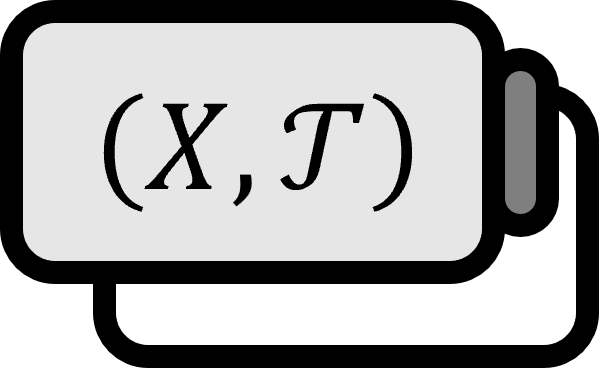The First Countable and the Second Countable
Definition 1
Let’s suppose that a topological space $X$ is given.
- If every point $x \in X$ has a countable local base, it is called a first-countable space.
- If $X$ has a countable base, it is called a second-countable space.
Explanation
Through the concepts of base and local base, a new branch of countability has been created.
Examples of spaces not being first-countable
Discrete spaces $\left( \mathbb{R} , \mathscr{T}_{f} \right)$ are not first-countable, and needless to say, they are not second-countable either.
Intuitive Understanding
Although not an accurate explanation, one can understand the first-countability as the feeling that at every point, there exists a countable number of open sets. On the other hand, the second-countability conveys a sense that a countable set encompasses the whole, closely related to the concept of separability. First-countability and second-countability are not mutually exclusive contrary to first-category & second-category and have an inclusion relationship. This can be readily verified by considering the relationship between a base and a local base. Moreover, as previously mentioned, second-countability not only resembles the concept of separability but in fact, it can also be shown to embody true separability.
Theorem
- [1]: Every second-countable space is a first-countable space.
- [2]: Every second-countable space is separable.
Proof
Every second-countable space is first-countable
If $X$ is a second-countable space, then $X$ will have a countable base $\mathscr{B}$.
Relationship between base and local base: If $\mathscr{B}$ is a base for $X$, then $\mathscr{B}_{x} := \left\{ B \in \mathscr{B} \ | \ x \in B \right\}$ is a local base for $x \in X$.
Since $\mathscr{B}_{x} = \left\{ B \in \mathscr{B} \ | \ x \in B \right\}$ is countable for all $x \in X$, $X$ is first-countable.
■
Every second-countable space is separable
Suppose $X$ is a second-countable space that has a countable base $\mathscr{B}$. For every non-empty set $B \in \mathscr{B}$, let’s choose $x_{B} \in B$ and define $D : = \left\{ x_{B} \in B \ | \ \emptyset \ne B \in \mathscr{B} \right\}$. Since $D$ is constructed by selecting elements from the countable base $\mathscr{B}$, $D$ is also countable, and proving $\overline{D} = X$ concludes the proof.
Let’s say $U$ is an open set that contains $x \in X \setminus D$.
Since $\mathscr{B}$ is a base for $X$, there exists $B \in \mathscr{B}$ satisfying $x \in B \subset U$. Since $x_{B} \in B \cap D$ and $x \notin D$, we have $$ D \cap (B \setminus \left\{ x \right\} ) \ne \emptyset $$. As mentioned earlier, since $B \subset U$, $$ D \cap (U \setminus \left\{ x \right\} ) \ne \emptyset $$ still holds. By the definition of a limit point, $x$ is a limit point of $D$, and since $x \in \overline{D}$, $X \setminus D \subset \overline{D}$ holds. Of course, since $D \subset \overline{D}$, to satisfy both conditions, it must be that $X = \overline{D}$.
■
Munkres. (2000). Topology(2nd Edition): p190. ↩︎
